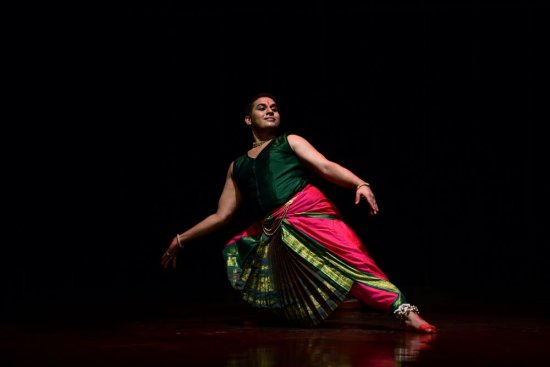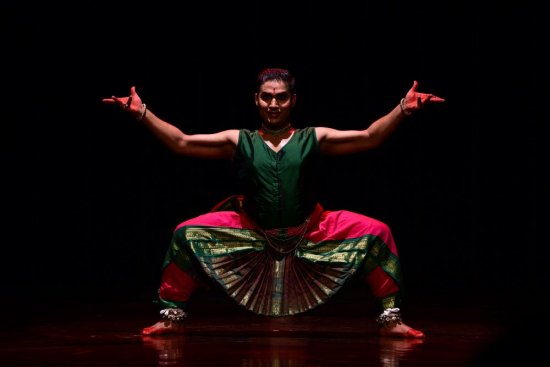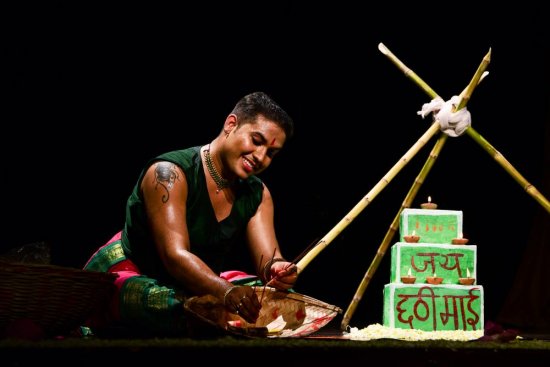
|   |

|   |
 e-mail: leelakaverivenkat@gmail.com Home truths in Abhadra of societal snobbery Photos: Lakshya photography June 11, 2024 Two factors prompted my visit to the Habitat - one to watch Bharatanatyam by a male disciple of Saroja Vaidyanathan (when I had associated male dancers in the Natyalaya as a recent phenomenon with Rama Vaidyanathan's male students), and the other that the dance was being rendered to Bhojpuri songs! After experiencing dancer Vinay Tiwari's creation and listening to the warm response of the audience, my first unvoiced thought was that Saroja Vaidyanathan would have been supremely happy to see the rewards of her labour. As gold medalist from Bhatkhande University, with a Nritya Nipuna title from Nalanda Dance School, plus a graded Doordarshan artiste, Vinay Tiwari has more than proved his dance credentials. With a senior diploma in Folk Dance and Masters in Sociology and Bharatanatyam, he is at present, as dance teacher in Prometheas Noida School, engaged in teaching folk forms and also Bharatanatyam to new learners. After 3pm, he is engaged at the Natyalaya working and learning (now a student of Rama Vaidyanathan) et al. As one who went through a gurukulavasam type of training, learning all aspects of the dance, staying in the Natyalaya premises throughout the day beside the Guru, working and training for more than two years, the dancer, during our exchange, reverentially refers to Saroja's patience as a teacher. "I was always amazed that a Padma Bhushan could be so simple with no high and mighty airs of any type. Sometimes, we would go over a step forty times, without her revealing any impatience at my inability to master the movement correctly." With moist eyes he mentions that never having been exposed to death, his pain at seeing his Guru lying lifeless was more than he could endure.  "What urged you to undertake this creative journey of Bharatanatyam rendered to Bhojpuri sahitya?" I asked. It is an involved story. Belonging to Devariya on the U.P-Bihar border, Vinay's talent for dance, finding limited expression in the annual function of the Saraswati Shishumandir school he studied in, enjoyed scant family approval - though Nanaji (no recollections of a father who died when he was 17 days old) secretly liked the idea of a rebel in the family. Mother as Principal of the Government Jain High School (holding family with 4 brothers together, and also first ever female teacher in the area) had him admitted in the school at Gorakpur, with the overriding condition that unless he got 80 percent marks, he would not be allowed to dance. He hated the school where everybody looked down on the way this Bhojpuria pronounced Hindi words. At the college stage, when he found his way into Lucknow Bhatkhande University finally, "it was as if the dance chose me rather than my choosing the dance," he says. Life was not easy, walking four miles daily to college and mother insisted that under no circumstances could dance be prioritized over formal education. But as a Yoga enthusiast, he had developed over time, a very supple body and when he went for an audition, he was selected. And with a broad choice comprising Gymnastics, Manipuri, Folk Dance, Bharatanatyam, Kathak, he opted for Bharatanatyam. He was into his fourth year when he first saw Rama Vaidyanathan perform the Mayura Alarippu, when she came for the Annual University Festival, and he was so taken up that he decided to learn it somehow. 'Sadu Madu Muralinath...' moved him tremendously. "All were dancing and it was a great feeling. I loved it". When Saroja herself came later to Bhatkhande, he was determined to learn from her. His lack of knowledge of English was always a problem (though now his fluency in the language would make one think that he has been educated in the English medium) and he quit the job he had in D.P.S, when he joined as one of Saroja Vaidyanathan's full time students - his mother, by then accepting the fact that the son's craving for dance was more than a whim. She helped with some funds, and gradually Saroja too realized that this student was a very committed dance seeker.  Talking of how he survived without a job, given this twenty four hour adherence to dance, Vinay observes in a tone of deep gratitude mixed with a sense of pride in his institution, "My Guru and Ganesa Natyalaya have made it a motto that any kind of student participation (outside the learning in classes) for the Natyalaya, has to be financially compensated. For the group performances by the school anywhere, every participating dancer is remunerated. When I take photographs of performances (Photography is a hobby with me) my pictures of a Natyalaya performance, if accepted, are never without monetary compensation- something I do not even expect. If students take an extra class, they get some compensation for it. I have not found any Guru who is so conscious of the fact that dancers (the least compensated among artistes) should never be exploited by Gurus." Sitting watching the 'Sur miley hamara' ad, with so many voices chiming in, Vinay wondered why such a situation could not exist in dance. All his life he had been troubled by the snob values attached to certain languages - while his own Bhojpuri was looked down upon as the language of the underdog - which is why he called his production Abhadra. "After all it is the mother tongue that expresses a person's innermost thoughts. While I danced to Carnatic music, how could the real person in me respond to Tamil, and other south Indian languages? I think of my sister living abroad, and her two children who are growing up with no knowledge of their mother tongue. I feel sad. I wanted to see my representation as a Bhojpuri in Bharatanatyam. Songs in Avadhi, Braj and others have been used as textual base for Bharatanatyam. Then why not Bhojpuri?" "Born out of Magadhi - Prakriti in Eastern India, the 2011 Census mentioned 50,600,000 speakers of Bhojpuri in India! Even today you find the language spoken by persons in Mauritius, Surinam, Guyana and Trinidad and Tobago. There are Muslims in Pakistan who speak Bhojpuri and are referred to as stranded Pakistanis. While many refer to Bhojpuri as a dialect, it was a language written in the Kaithi script during Mughal days. Now it is in Devanagari. In Jharkhand, even today, Bhojpuri is given the status of a second language. Bhojpuri literature boasts of plays and books written during the Quit India movement. Bhojpuri Academy by a Maithili, brought out several journals. Words from Bengali are found in Bhojpuri. Considering these factors, why this step motherly treatment to this language?"  Now studying under Rama Vaidyanathan, Vinay is thankful for her valuable inputs. "I still am self-conscious when I dance before her and I very hesitantly showed her what I had created." Her very encouraging response to his work boosted his confidence. Rama's Mayur Alarippu had always inspired him. Wondering on how to start, he had finally settled for Himanshu Srivastava's idea of beginning with Chhat Pooja prayer - so much a part of the Bihari. Paying homage to the Devi with spear, through epithets Dhanam Dehi, Dharmam Devi, Bhoomi Devi, Hridayam Devi etc, it is in the Cat Alarippu that one gets a real impression of this dancer's creative imagination. "Dancers need to become philosophers, and I decided that the vahana of the Goddess would be the cat, and visualized the Alarippu with a clever twist in the movements for the Tam dhit Tam, Thai dhit tai syllables to suit this theme. Nobody could give me authentic ideas on this subject," he said. The stance, gait and rounded movements in the choreography remind one of "a cat sitting (beside me) licking and rubbing its body and face." His descriptions explained a lot of my own queries as to why a dancer with his almost boneless, supple ability, should, in the demi pliť, be bending so much in front, from the waist! After having danced to Carnatic vocal music always, the dancer now had to begin thinking in terms of the Bhojpuri vocal. Using his mother's untrained voice, with Vasudevan's professional expertise providing the compositional finish, with Jai Dhadheeji helping with some of the Bhojpuri sahitya and with instrumentalists like Rajat Prasanna providing telling touches on the flute, and above all mridangam support by Sannidhi Vaidyanathan. The sahitya spoken with minimal musical flourishes provides the background. After all, the item concentrates on the word - very little background music.  The plot starts with the male child being born in the family, and songs celebrating such an occasion abound in Bhojpuri. "Raja Dasharath ke gharwa aaj jan me lalanwa" the family rejoices. Songs rocking the toddler placed on the women's knee and lower leg singing gughuwamane.... is a common occurrence. This vatsalya acquires an erotic sringar tone very different, when the grown up lad falls in love and gets married. Referring to the profusion of nuptial songs in Bhojpuri, Vinay mentions a composition wherein the bride having lost her earrings in the night's love play asks, "Jhumka katahi giralba rati ki chedkhanime?" The man, as very often happens, sets off for a foreign land seeking to enhance his professional qualifications. "Mat ja bidesha," (Don't go to a foreign land) beg the women folk. The initial wonder and glamour of a western city soon begin to pall, with an increasing feel of being a misfit amidst people who ridicule him for his lack of sophistication - for not being able to use a fork and knife with ease, or finding the traffic signals and road signs confusing, and landing at wrong places asking for directions - where again his pronunciation evokes hurtful laughter and remarks - the proverbial dropping of h's, so to speak, when he converses in English. As Vinay talks of constantly listening to Lady Gaga to improve his English, succinctly puts it "The Sa to sha Yatra is so big." What is creditable is the manner in which through spoken bits and actions, and very telling mime, the dancer conveys his message, evoking deep sympathy. And the incidents and metaphors chosen seem so close to life! When the Pardesi finally decides to come back home, it is to bid goodbye to his dead mother's bier being carried with the song associated with happiness, used like a dirge - Tannvo chootal, Mannavo chotal choot gayi mo se mor gauwan, Loriya chootal suhariya chootal choot gaye gauwan ke barua mayi chotal, Matiyo chotal, choot gayi nadiya ki kinarwa. It was a deeply moved audience that rose to acknowledge the bold, new attempt. More muscle to this Bhojpuri dancer of Bharatanatyam!  Writing on the dance scene for the last forty years, Leela Venkataraman's incisive comments on performances of all dance forms, participation in dance discussions both in India and abroad, and as a regular contributor to Hindu Friday Review, journals like Sruti and Nartanam, makes her voice respected for its balanced critiquing. She is the author of several books like Indian Classical dance: Tradition in Transition, Classical Dance in India and Indian Classical dance: The Renaissance and Beyond. Post your comments Pl provide your name and email id along with your comment. All appropriate comments posted with name and email id in the blog will also be featured in the site. |